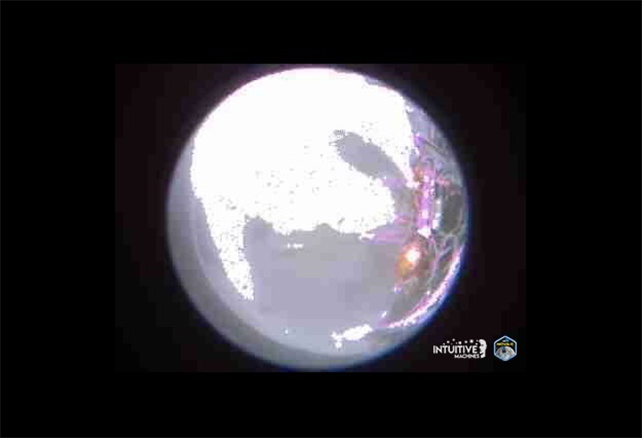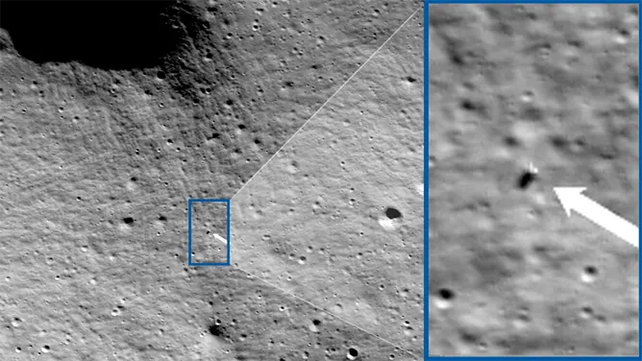ARTICLE AD
Space27 February 2024
By Alan Boyle, Universe Today
 The Odysseus lander captured this image about 35 seconds after pitching over during its approach to the lunar landing site. The ultra-wide-angle view shows Odysseus and its landing legs at the bottom of the frame. (Intuitive Machines)
The Odysseus lander captured this image about 35 seconds after pitching over during its approach to the lunar landing site. The ultra-wide-angle view shows Odysseus and its landing legs at the bottom of the frame. (Intuitive Machines)
Four days after Intuitive Machines' Odysseus lander made an off-kilter touchdown on the Moon, the mission team is releasing snapshots that were taken during its descent.
The ultra-wide-angle images confirm that the lander is continuing to communicate with flight controllers, even though it's lying in an awkward angle that limits how much data its antennas can transmit.
Meanwhile, images from NASA's Lunar Reconnaissance Orbiter have identified Odysseus' landing spot, within a mile (1.5 kilometers) of its intended target near a crater called Malapert A in the Moon's south polar region. The bad news is that the solar-powered lander may have to go dark sooner than anticipated.
The lander is the first-ever commercial spacecraft to survive a descent to the Moon, and the first U.S-built spacecraft to do so since NASA's Apollo 17 mission in 1972. NASA is paying Intuitive Machines $118 million to deliver six science payloads to the surface, and there are another six private-sector payloads on board.
Odysseus' descent wasn't easy: Just hours before the landing, the Nova Control team had to reprogram the lander to work around a disabled laser range-finding system. The spacecraft instead made use of one of the NASA payloads, an experimental laser range-finding system. Fortunately, the work-around worked.
 This low-resolution, ultra-wide-angle image from the Odysseus lander shows the lunar terrain with a scrunched view of the lander itself off to the right side of the frame. (Intuitive Machines)
This low-resolution, ultra-wide-angle image from the Odysseus lander shows the lunar terrain with a scrunched view of the lander itself off to the right side of the frame. (Intuitive Machines)The lander also hit the dirt faster than originally planned, with a lateral motion that's thought to have tripped up one of Odysseus' landing legs. As a result, the spacecraft is lying on its side. Mission managers say that doesn't seem likely to affect data collection, but it is affecting data transmission.
Lunar Reconnaissance Orbiter's images from this past weekend indicate that Odysseus hit a bull's-eye, just like the hero from Greek mythology after whom it was named.
 An overhead image from NASA's Lunar Reconnaissance Orbiter shows the location of the Odysseus lander, highlighted by the blue-bordered inset. (NASA/Goddard/Arizona State University)
An overhead image from NASA's Lunar Reconnaissance Orbiter shows the location of the Odysseus lander, highlighted by the blue-bordered inset. (NASA/Goddard/Arizona State University)"After traveling more than 600,000 miles, Odysseus landed within 1.5 kilometers of its intended Malapert A landing site, using a contingent laser range-finding system patched hours before landing," Intuitive Machines said in today's update.
But Intuitive Machines also suggested that Odysseus won't be able to remain in operation for the week to 10 days that mission managers had hoped for.
"Flight controllers intend to collect data until the lander's solar panels are no longer exposed to light," according to the update. "Based on Earth and Moon positioning, we believe flight controllers will continue to communicate with Odysseus until Tuesday morning."
Maybe Odysseus and its controllers will have to hope for an unexpected revival similar to what the team behind another off-kilter Moon lander, Japan's SLIM spacecraft, experienced this weekend.
This article was originally published by Universe Today. Read the original article.

 11 months ago
64
11 months ago
64 

